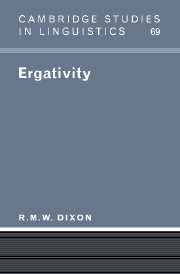Book contents
- Frontmatter
- Contents
- Preface
- Acknowledgements
- Appeal
- List of abbreviations
- 1 Introduction
- 2 Syntactically based and semantically based marking
- 3 Intra-clausal or morphological ergativity
- 4 Types of split system
- 5 The category of ‘subject’
- 6 Inter-clausal or syntactic ergativity
- 7 Language change
- 8 The rationale for ergativity
- Appendix: A note on theoretical models
- References
- Index of authors
- Index of languages and language families
- Subject index
3 - Intra-clausal or morphological ergativity
Published online by Cambridge University Press: 06 July 2010
- Frontmatter
- Contents
- Preface
- Acknowledgements
- Appeal
- List of abbreviations
- 1 Introduction
- 2 Syntactically based and semantically based marking
- 3 Intra-clausal or morphological ergativity
- 4 Types of split system
- 5 The category of ‘subject’
- 6 Inter-clausal or syntactic ergativity
- 7 Language change
- 8 The rationale for ergativity
- Appendix: A note on theoretical models
- References
- Index of authors
- Index of languages and language families
- Subject index
Summary
Every language has intransitive clauses, with a predicate and a single core argument (that we call S) and transitive clauses, with a predicate and two core arguments (A and O). There should always be the means to distinguish A and O. Some languages do this by constituent order (e.g. English), some use cases, particles or adpositions, and some employ pronominal cross-referencing on the verb (many languages employ a combination of these strategies). The marking of core syntactic relations – A, S and O – is generally referred to as ‘morphological ergativity’ or ‘morphological accusativity’ since this is generally shown by case inflections or verbal cross-referencing affixes. A more exact label would be ‘intra-clausal ergativity/accusativity’, since particles and adpositions make use of a syntactic – not a morphological – mechanism, and constituent order is without doubt a matter of syntax.
There must be some means of distinguishing A and O for a transitive clause. The marking of S in an intransitive clause can be the same as A, or the same as O, or different from both. There are thus three basic possibilities:
S = O (absolutive), A different (ergative) – an ergative system
S = A (nominative), O different (accusative) – an accusative system
A, S and O all different – this is a ‘three-way’ or ‘tripartite’ system.
The accusative pattern is, of course, commonest among the languages of the world. The ergative pattern, with which this book is concerned, is by no means uncommon.
Information
- Type
- Chapter
- Information
- Ergativity , pp. 39 - 69Publisher: Cambridge University PressPrint publication year: 1994
